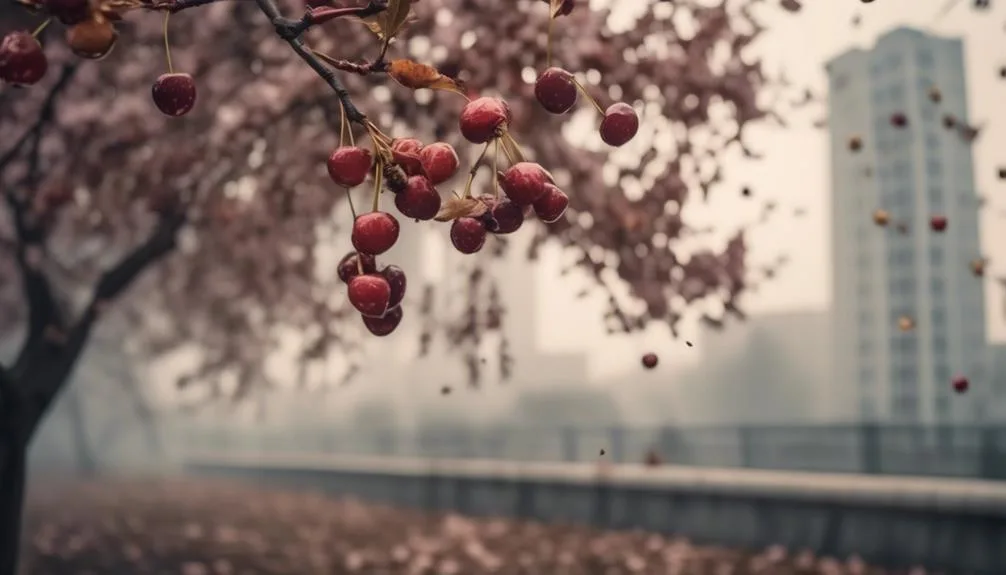Cherry trees, like canaries in a coal mine, can indicate environmental health. Understanding how air pollution affects them is crucial for our surroundings. These iconic trees are more vulnerable than you might think.
Stay tuned to learn about the complex relationship between cherry trees and the air we breathe.
Impact of Air Pollution on Cherry Trees
Air pollution poses a significant threat to the health and growth of cherry trees. Poor air quality can result in reduced photosynthesis, stunted growth, and increased susceptibility to diseases and pests. When cherry trees are exposed to high levels of air pollutants such as ozone and sulfur dioxide, their leaves can exhibit characteristic injury symptoms, leading to decreased tree health. Additionally, air pollution can disrupt the balance of essential nutrients within the trees, further compromising their resilience.
It's crucial to monitor and address air quality issues to safeguard the health of cherry trees and ensure their continued growth and productivity. By mitigating air pollution, we can protect these valuable trees and preserve their contribution to our environment.
Signs of Air Pollution Damage on Cherry Trees
Experiencing the effects of air pollution on cherry trees can manifest in various visible signs that indicate damage to their health and overall well-being. Keep an eye out for these signs of air pollution damage:
- Leaf Discoloration: Look for yellowing, browning, or premature dropping of leaves.
- Stunted Growth: Notice if the trees aren't growing as tall or as full as expected.
- Fruit Deformities: Check for abnormalities in the size, shape, or color of the cherries.
- Increased Susceptibility to Pests and Diseases: Monitor if the trees are more prone to infestations or infections.
Prevention and Protection for Cherry Trees
To ensure the health and vitality of your cherry trees, it is essential to implement preventative measures and protective strategies against air pollution. Being proactive in safeguarding your cherry trees from environmental factors can significantly improve their resilience. Here are some measures you can take to protect your cherry trees:
| Preventative Measures | Protective Strategies |
|---|---|
| Planting pollution-tolerant cherry tree varieties | Using physical barriers such as hedges to reduce exposure |
| Regularly watering and fertilizing to maintain tree health | Applying anti-transpirants to reduce pollutant uptake through leaves |
| Pruning to remove damaged or diseased branches | Monitoring air quality and adjusting planting locations accordingly |
| Using mulch to reduce soil compaction and improve root health | Installing air filtration systems in urban or high-pollution areas |
Recovery and Restoration for Cherry Trees
You can aid in the recovery and restoration of your cherry trees by implementing targeted care and maintenance practices. Here's how:
- Pruning: Trim damaged or diseased branches to promote new growth and improve overall tree health.
- Fertilization: Use organic, slow-release fertilizers to replenish essential nutrients and improve soil health.
- Replanting Techniques: If necessary, consider replanting cherry trees in fresh, well-draining soil to support their recovery.
- Soil Health: Conduct soil tests to assess nutrient levels and pH, then amend the soil as needed to create optimal growing conditions for your cherry trees.
Conclusion
In conclusion, prioritizing targeted care and maintenance practices will greatly contribute to the recovery and restoration of cherry trees in the face of environmental challenges such as air pollution.
It's essential to continue researching the specific impacts of air pollution on cherry trees and to develop effective mitigation strategies. Future research should focus on understanding the mechanisms by which air pollutants affect cherry trees at the cellular and molecular levels, as well as identifying genetic variations that may confer resistance to air pollution.
Additionally, investigating the long-term effects of air pollution on cherry tree populations and ecosystems is crucial for developing sustainable management practices.
Conclusion
In caring for cherry trees amidst air pollution, vigilance for signs of damage and proactive measures like proper watering and soil management are crucial.
Preserving these trees not only safeguards their beauty but also sustains a healthy environment for generations to come.
How can we ensure the longevity of these delicate natural wonders?

My interest in trees started when I first saw the giant sequoias in Yosemite.
I was a teenager then, and I remember thinking, “I need to learn more about this.”
That moment stuck with me.
A few years later, I went on to study forestry at Michigan Tech.
Since graduating, I’ve worked in a mix of hands-on tree care and community education.
I’ve spent over ten years helping people understand how to plant, maintain, and protect the trees in their neighborhoods.
I don’t see trees as just part of the landscape.
They are living things that make a real difference in our daily lives.
